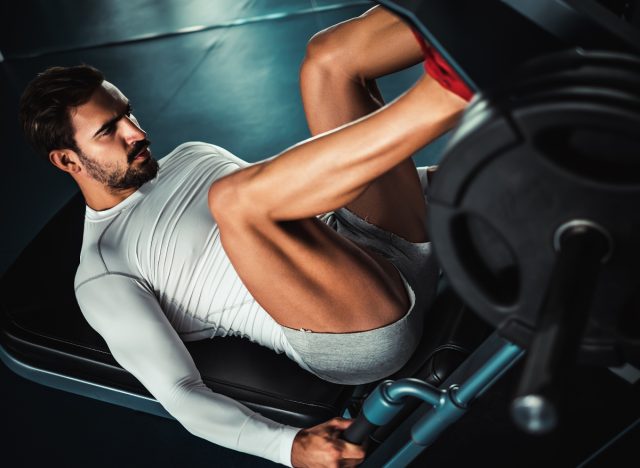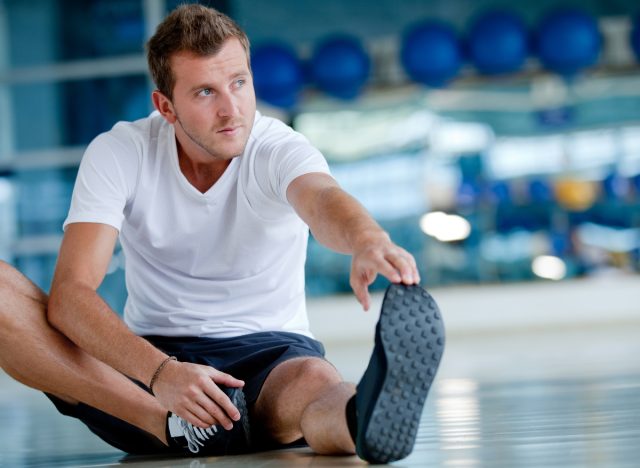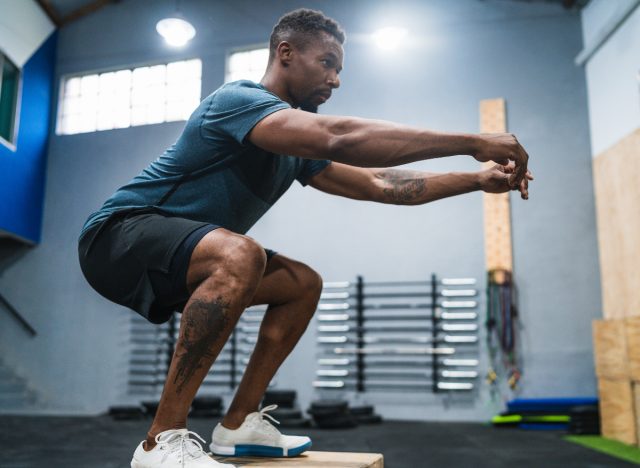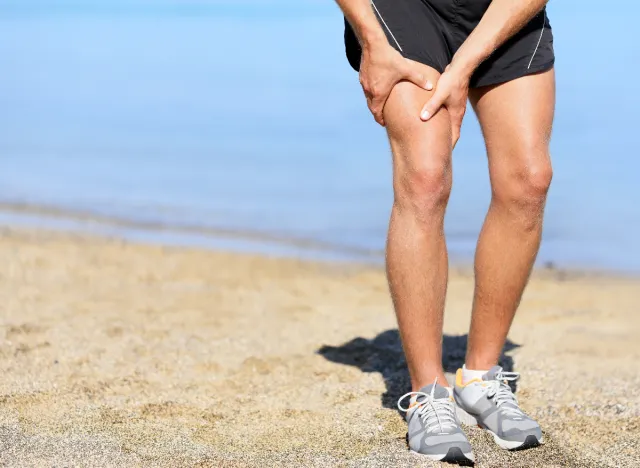Are you under 40 and worried about the health of your legs? If so, you’re not alone. Taking care of your legs is critical, especially as you approach the big 4-0 milestone. Not to mention that maintaining strong legs and overall lower-body strength is crucial to reduce your fall risk and sustaining balance and mobility as you get older, according to a study published in the Journal of Physical Therapy Science. However, certain fitness habits can take a toll on your legs, leaving you sidelined and frustrated. Today, we’re walking you through six fitness habits that destroy your legs before 40.
To help you avoid these habits and keep your legs in tip-top shape, we chatted with Rose McNulty, CPT, NASM-certified personal trainer and nutrition coach with Garage Gym Reviews, who reveals the detrimental effects that these habits can have on your joints and muscles. Regardless of your fitness level or preferred form of exercise, staying clear of these harmful habits can help you keep your legs toned, fit, and strong so you’re ready to take on any challenge.
Read on to learn more about the six fitness habits that destroy your legs before 40, then check out The Best Leg-Strengthening Exercises for Women.


While leg workouts are essential for building strength and endurance, overtraining can lead to muscle fatigue, strain, and injury. You should listen to your body’s signals and include rest days into your fitness routine to avoid overtraining syndrome. Either switch up your target muscle groups and give your legs a day or two to rest while you train other body parts, or do light activity between sessions to get the blood flowing and help your muscles recover gently.
“Overtraining muscle can lead to a progress plateau—or worse, injuries,” cautions McNulty. “The same goes for your legs, so make sure to plan a balanced schedule of workouts and rest. It’s also important to remember that while muscles grow due to training, they do the repairing needed to grow while you rest.”


Stretching is an often overlooked aspect of fitness, but it plays a crucial role in maintaining flexibility, improving range of motion, and reducing injury risk, according to a study published in the Journal of Physical Therapy Science. Make sure to stretch after you’ve warmed up, not before, and only stretch to the point of slight discomfort, not pain.
“When it comes down to it, all of your muscles work together to get you moving and perform even the simplest activities,” says McNulty. “In the legs, it’s obvious that all of your muscles work like links in a chain—that’s why dedicating time to stretching is important. When one muscle is tight or injured, the rest compensate, leading to further imbalances or injuries.”


Whether at a desk or in front of the TV, excessive sitting can contribute to tight hip flexors and weakened glutes, according to research. So be sure to take frequent breaks to stand up, stretch, and go for short walks to avoid damaging your legs in the long term.
READ RELATED: Power of Weighted Vests: Enhancing Fitness and Cardiovascular Health
“Sitting for long periods can lead to tight leg and hip muscles over time. This can snowball into a plateau or injuries during workouts if you don’t take the time to stretch the muscles on the front of your legs and do movements to mitigate imbalances, like squats and glute work,” explains McNulty.


“High-impact exercises such as running or plyometric workouts are fine in moderation and can bring you closer to your fitness goals, but these types of training can also be hard on your joints,” says McNulty. “Unless you’re specifically training for an endurance event in a high-impact activity, like running, it’s wise to switch up the forms of training you do to prevent injuries resulting from overuse of the same muscles repeatedly.”
Vary your workout routine, and incorporate low-impact exercises such as swimming or cycling to give your legs a break while remaining active.


Pain is your body’s way of telling you that something’s wrong. Seek professional advice and adjust your workouts if you experience persistent discomfort or leg pain.
“The old saying goes, ‘No pain, no gain’—and it’s time to forget about it. While exercise isn’t exactly comfortable, acute pain during a workout shouldn’t be ignored. Pushing through may feel tough, but the right thing to do is stop what you’re doing when sharp pains happen, consult with a medical professional if the pain doesn’t subside, and give yourself adequate time to recover,” advises McNulty.


The last of the worst fitness habits that destroy your legs after 40 has to do with neglecting nutrition. “Nutrition is a massive piece of the puzzle regarding maintaining a healthy weight,” states McNulty. “And when it comes to healthy joints, maintaining a healthy weight is important to help prevent hip pain, knee pain, or even osteoarthritis in the long run. Obesity can also increase general inflammation throughout the body, increasing the risk of chronic diseases over time.”
Ensure you’re consuming a balanced diet rich in essential nutrients, including protein, vitamins, and minerals to support healthy weight management and reduce strain on your lower body.











